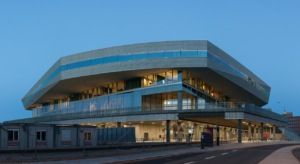News
Construction error on culture centre in Aarhus will cost millions to fix
This article is more than 9 years old.
Over 6,000 sqm of exterior wallboards on the waterfront building Dokken have to be replaced

Dokken in Aarhus houses the main city library, theatres and a municipal public services department (photo: Gardar Rurak)
Not even a year has passed since its grand opening but the Dokken culture centre on the Aarhus waterfront, one of the most expensive buildings ever constructed in the Jutland city, has to be repaired.
A technical evaluation has revealed that the building’s 6,400 sqm of special wind barrier plates need to be replaced to prevent the risk of rusting and rotting – a construction error that is estimated to cost about 13 million kroner.
The culture centre is covered by magnesium oxide wallboards that were supposed to protect the building from wind, but instead are sucking in moisture and could cause significant damage to the construction.
READ MORE: Aarhus among Lonely Planet’s top European destinations
Looking for the culprit
According to Niels Højbjerg, a senior official at Aarhus Municipality, an investigation has yet to determine who is responsible for the mistake and how much exactly the repair will cost.
Dokken was designed by the architect group Schmidt Hammer Lassen and Kristine Jensen and the construction work was managed by the Swedish construction company NCC AB.
The waterfront building cost over 2 billion kroner and houses the city’s main library, the municipal public services department, theatres, various businesses and a large automated underground parking facility.
Some 3,600 people visit the culture centre every day.










































